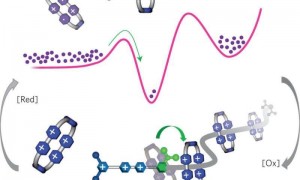The first artificial molecular pump that uses non-equilibrium chemistry was developed by a team of Northwestern scientists, in which molecules pump other molecules. This tiny machine is no small feat. The pump one day might be used to power other molecular machines, such as artificial muscles.
The new machine mimics the pumping mechanism of life-sustaining proteins that move small molecules around living cells to metabolize and store energy from food. For its food, the artificial pump draws power from chemical reactions, driving molecules step-by-step from a low-energy state to a high-energy state, far away from equilibrium. This molecular pump is radical chemistry, an ingenious way of transferring energy from molecule to molecule, the way nature does.
All living organisms, including humans, must continuously transport and redistribute molecules around their cells, using vital carrier proteins. Scientists are trying to recreate the actions of these proteins using relatively simple small molecules we make in the laboratory.
Stoddart’s team has been working on artificial molecular machines for several years. One challenge they have faced for quite a while is how to power their machines. This latest advance may allow them to make machines that perform tasks at the molecular level.
Paul R. McGonigal, one of authors of the study, said: “This is non-equilibrium chemistry, moving molecules far away from their minimum energy state, which is essential to life. Conducting non-equilibrium chemistry in this way, with simple artificial molecules, is one of the major challenges for science in the 21st century. ”First author Chuyang Cheng, a fourth-year graduate student in Stoddart’s laboratory, added: “In some respects, we are asking the molecules to behave in a way that they would not do normally. It is much like trying to push two magnets together. The ring-shaped molecules we work with repel one another under normal circumstances. The artificial pump is able to syphon off some of the energy that changes hands during a chemical reaction and uses it to push the rings together.”
The miniscule molecular machine threads the rings around a nanoscopic chain, a sort of axle, and squeezes the rings together, with only a few nanometers separating them.
Currently, the artificial molecular pump is able to force only two rings together, but the researchers believe it won’t be long before they can extend its operation to tens of rings and store more energy.
For more information please visit: www.northwestern.edu

